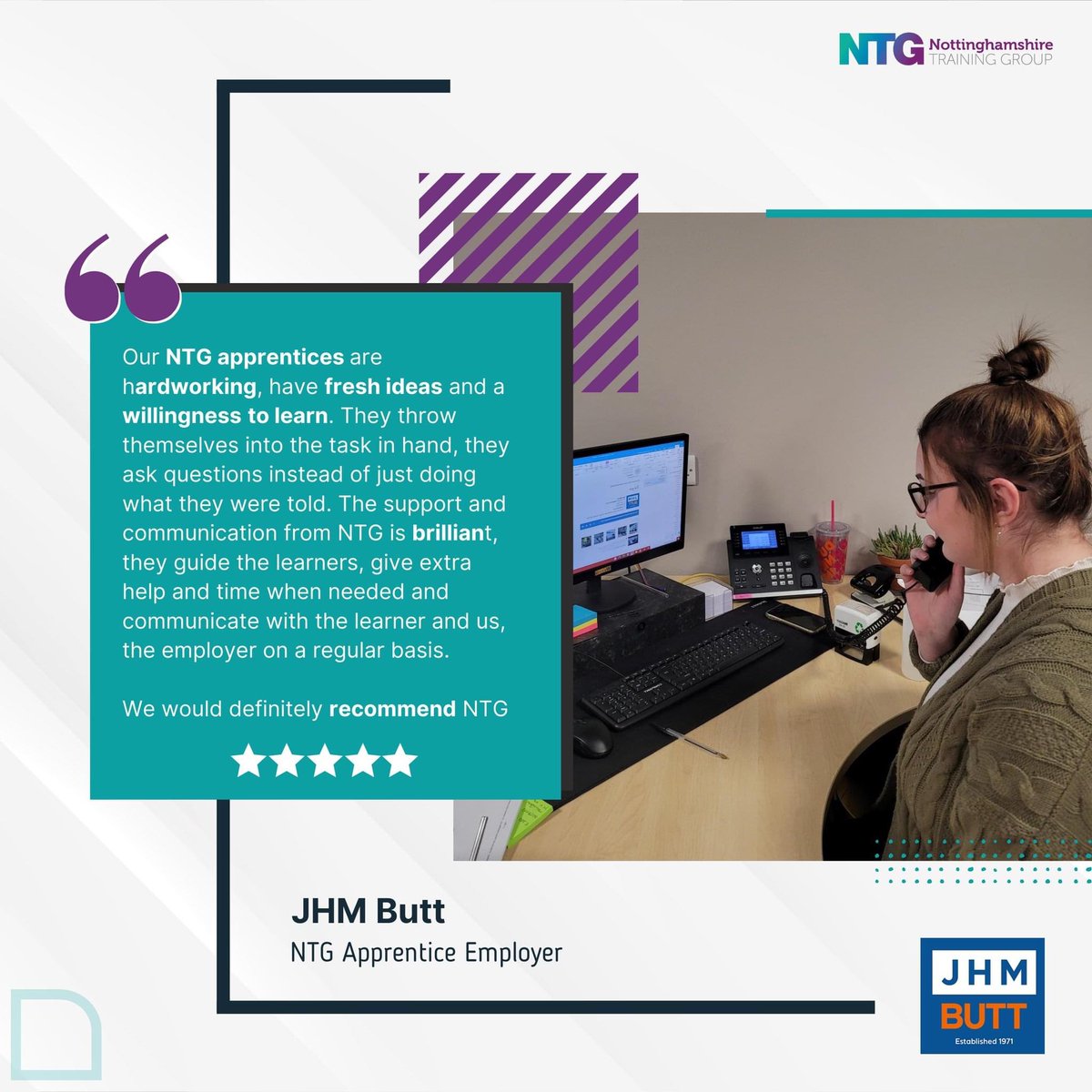Apprenticeships
Whether you’re considering leaving school to take your first step into employment, want to find out more about Apprenticeships for someone else or are an employer who is considering taking on an Apprentice to grow your workforce…
What is an apprenticeship?
An apprenticeship is a work-based learning programme that combines teaching off the job with learning and practice in the workplace. It allows the apprentice to acquire and apply the skills and knowledge you require in your organisation. Apprenticeships normally last between 12 and 24 months and we offer two levels:
Apprenticeships – equivalent to five GCSE grades 9 - 4. An apprenticeship enables new and existing employees to obtain skills at NVQ level 2 standards. The apprentice is employed by you, and the training programme usually lasts for approximately 12 to 18 months although progress can be made more quickly. Successful apprentices progress to:
Advanced Apprenticeships – equivalent to two A level grades A - C. An advanced apprenticeship develops the learner’s skills at NVQ level 3 standards as potential supervisors, skilled youth workers and managers. Again, the apprentice is employed by the company but the training programme usually lasts for about 18 to 24 months but some advanced apprentices complete more quickly, particularly if a level 2 apprenticeship has been taken previously.
Apprenticeships are made up of industry specified components known as the ‘Framework’, or from June 2017 ‘Standards’, all components are essential to achieve full completion: Competence Based Learning provides practical skills in specific occupational areas.
- Technical certificates – vocationally related qualifications that provide the underpinning knowledge required.
- Functional Skills qualifications – transferable work related skills like IT and communication, application of number, problem solving, teamwork and improving learning and performance
- General employment rights and responsibilities.
- Personal thinking and Learning Skills.
There may also be optional units, designed to suit the differing requirements of individual organisations.
Why Apprenticeships? - 20 Useful Facts
There has never been a better time to employ an apprentice or start an apprenticeship:
- Apprenticeship participation now stands at a record level - there were 509,400 apprenticeship starts in the 2015 to 2016 academic year of which 131,400 were under 19.
- There are, on average, 23,000 apprenticeship opportunities listed on find an apprenticeship every month.
- There were 1,656,680 online apprenticeship applications in 2015 to 2016.
- More than 2,600 employers are involved in designing the new apprenticeships standards.
- Over 510 apprenticeship standards have been published or in development, with over 165 ready for delivery.
- There have been 12,200 starts on new standards since their introduction with 7,500 of these starts reported so far in the first two quarters of the 2016 to 2017 academic year.
- There are currently 100 higher and degree apprenticeships available, with more in development, including foundation degrees, HNDs and full honours degrees. These include job roles ranging from legal services to banking and engineering.
- Nearly all apprentices feel that they acquire or improve their skills as a direct result of their apprenticeship.
- 89% of apprentices are satisfied with their apprenticeship; 97% of apprentices said their ability to do the job had improved, and 92% of apprentices said their career prospects had improved.
- Over 90% of apprentices currently go into work or further training.
- Higher apprentices could earn £150,000 more on average over their lifetime compared to those with level 3 vocational qualifications.
- 36% of higher apprentices report getting a promotion after completing their apprenticeship.
- Nearly 9 out of 10 (89%) apprentices were satisfied with their apprenticeship overall, and nearly three quarters (72%) were very satisfied.
- The majority (92%) of apprentices in work felt that their apprenticeship had had a positive impact on their career.
- Almost 9 out of every 10 apprenticeship employer hoping to achieve business benefits tell us that apprenticeships deliver.
- 87% of employers said they were satisfied with the programme, 76% say that productivity has improved and 75% reported that apprenticeships improved the quality of their product or service.
- 10.6% of apprentices were from a BAME background in 2015, we are working to increase this by 20% by 2020.
- Apprenticeships have helped to train 7% more females into STEM (science, technology, engineering and maths) roles.
- Traineeships have been developed by employers making them a great stepping stone to an apprenticeship or other job.
- 94% of employers consider traineeships an effective way of increasing young people’s chances of finding paid jobs and apprenticeships.
Common Q&As
What do you mean by ‘frameworks’ and ‘standards’?
Both frameworks, and the new standards, are written definitions of the learning requirements for apprenticeship programmes. They are developed to ensure that all apprenticeship programmes are delivered and measured consistently. In order to ensure that apprenticeships are employer led, frameworks are gradually being replaced by apprenticeships standards which are developed by groups of employers.
What’s special about the new apprenticeships standards?
The overall objective of the new apprenticeships standards is to ensure that apprenticeships are truly employer led.
Standards are therefore designed by employers (Trailblazer groups) to meet their needs, the needs of their sector and the economy more widely.
Guidance around the development of the standards specifies that they need to be short, easy to understand documents that describe the knowledge, skills and behaviours required to undertake a specific occupation well, and to operate confidently within a sector.
The new standards focus on how an apprentice should demonstrate mastery of an occupation, and meet professional registration requirements in sectors where this exists (for example, in engineering, science and accountancy). The approved standard therefore is a concisely written document that outlines the skills, knowledge and behaviours required of the apprentice and the job they need to be able to do by the time they have completed their apprenticeship.
What do all standards have in common?
To ensure every standard is of high quality there are seven criteria that all apprenticeship standards must meet which are:
- Be short and concise
- Set out the knowledge, skills and behaviours needed in an occupation, so that, on completion, the apprentice is able to competently carry out the role in any size of employer across any relevant sectors
- Have the support of employers including smaller businesses
- Be sufficiently stretching so that it will require at least a year of training (before the end point assessment) with off the job training accounting for at least 20% of the apprenticeship
- Align to professional registration where it exists
- Contain minimum English and maths requirements and any digital skills required
- Only include mandatory qualifications under certain circumstances.
Where can I find more info?
To find out more information on the future of apprenticeships visit: futureapprenticeships.org.uk/.
What else do I need to know?
What else do I need to know about the apprenticeship programme?
Apprenticeships are relevant to both new and existing employees so just like all existing staff, most of existing employment conditions will automatically apply, including a written contract of employment that sets out an apprentice’s terms and conditions of employment and training.
Job title and description
The apprentice must be assigned a job title and given a job description. This should also include a description of their duties, start date, details of the probationary period and the duration of the contract of employment if it is fixed term. Many employers treat the apprenticeship as discrete employment with a fixed term. Once completed they would then issue a new permanent contract of employment to the now qualified ex-apprentice.
Hours of work
The employer is entitled to set the hours of work. Apprentices are subject to the Working Time Regulations and as such should work no more than 40 hours per week (under 18s) and 48 hours (over 18s). These hours of work include any off the job training they need to attend. Apprentices can work the working patterns of the qualified workforce.
Salary
Apprentices aged 16 to 18 must be paid no less than the national minimum apprenticeship wage.Full information can be access here... "http://www.gov.uk/national-minimum-wage-rates". Incremental rises based on progress through the apprenticeship and work experience are widely used by employers. This is very effective as a motivator or a form of recognition. Apprentices aged 19+ can be paid no less than the minimum apprentice wage per hour for the first year of their apprenticeship and are then paid no less than the National Minimum Wage for their age in their second year.
Annual leave
Apprentices are entitled to a minimum of four weeks paid annual leave (inclusive of Bank Holidays). This entitlement begins after they have been employed for 13 weeks.
Disciplinary and grievance procedure and sickness arrangements
Apprentices are subject to the same arrangements as other employees. They should be made aware of the disciplinary procedure that operates in your workplace and the procedures to be followed in the event of sickness.
Induction
NTG will run an induction with the apprentice that explains many aspects of their apprenticeship, and you will need to cover specific details that relate to their place of work.
At the very least, induction should cover the following:
- The organisation, its history, objectives and organisational structure;
- A tour of the premises and introduction to key people, staff, volunteers and service users as appropriate;
- Confirmation of the terms and conditions of employment, company rules and procedures;
- Health, safety and welfare (see later for more detail on health, safety and welfare).
Who and What is involved?
Who will be involved in the apprenticeship programme?
Most importantly, an apprentice (YOU!) In addition to the employment commitments the apprentice also has a range of commitments to their training programme, these include:
- Agree a Learning Plan with all parties who are involved.
- Attending meetings with trainers, assessors and verifiers as required.
- Attending off-the-job training where required.
- Providing evidence of competence.
- Developing a collection of evidence - a portfolio - throughout the period of the apprenticeship.
One or more skilled employees
The employers staff team will help to support the apprentice by introducing them to new tasks / areas of their job role and providing training, supervision and encouragement throughout the programme.
A designated Tutor – who you’ll identify It is important that the apprentice has a single point of contact. They can give them support and answer their queries. This could be you or another member of your staff team. Whoever you choose needs to have an empathy with young people and learning.
The learning provider - Consortia Training and the given training centre. We also have a vital role to play to ensure the success of the apprenticeship.
We are responsible for:
- Assigning an industry qualified tutor and ensuring the apprenticeship meets the requirements of the awarding body through Internal and External Verification.
- Planning the learning.
- Reviewing progress.
- Assessing the apprentice.
- Claiming certificates.
The tutor – we’ll provide this The tutor will work with the apprentice and designated mentor to:
- Develop the Learning Plan and Training Agreement.
- Deliver the programme, bringing together the various elements of an apprenticeship to produce a coherent, integrated programme.
- Monitor, support and guide all parties throughout the programme.
- Ensure standards are met for all aspects of the programme including health and safety and equal opportunities.
Pastoral Support – We understand that It is important to remember apprentices are often young people who are making the transition into working adults. It is helpful for them to have access to someone who they can talk to about other issues, which may be personal issues that they don’t want to share with work colleagues. Evidence shows that this can make a real difference and help to keep an apprentice on track.
The Employer — will provide:
- Highlight opportunities for the apprentice to learn skills and demonstrate competence.
- Meet with trainers, tutors, verifiers and the apprentice to review progress (see delivery model and review cycle).
- Witness apprentice performance and authenticating evidence.
- Release the apprentice for any on / off-the-job training in line with the agreed Individual Learning Plan.
- Support and encourage the apprentice and reward achievement.
Call us today on 01909 477669 to see how an apprenticeship may suit you or you child as the next step towards a worthwhile career.










